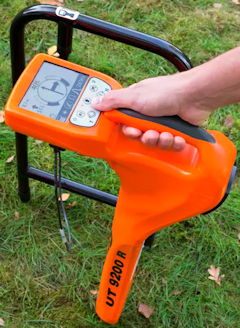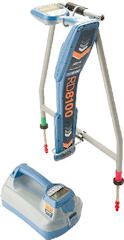Cable Fault Locators
Sewerin UT9200 Cable Locator
- An arrow the top of the cable fault finding frame clearly shows which end of the probe faces forward with the locator direction.
- The fault strength number guides to the direct buried cable fault location and shows the intensity of cable fault to compare to other faults on the cable.
- When the arrow changes direction, the cable fault is centered between the probes.
Radiodetection Cable Ground Fault Locators
The Cable Fault Locator A-Frame easily connects to the RD8200, RD7200, underground cable fault locator receivers converting it to a ground cable fault locator including secondary power cables. Arrows on the locator receiver's LCD easily guide the operator to cable fault when the transmitter is connected to a faulted cable.
- Arrows point towards the cable fault
- The cable fault locator automatically changes to the cable fault location frequency when the A-frame when it's connected
- The A-frame connects to the cable locator for single or two hand use
- Display shows the fault signal strength to determine whether there may be other faults on the same cable.

When near the cable fault, the forward or backward arrows point towards the fault where ever you place the A-frame. The signal strength number shows the strength of the cable fault to determine if there is another fault on the cable and which fault is the major fault.
Rycom Underground Cable Fault Locaters
The Rycom cable ground fault frame finds locations the locations where the insulation of direct buried cables is damaged and shorted to the earth.
Great value without requiring an expensive locator to connect to.
- Made in the USA
- Great value without requiring an expensive full featured locator to connect to.
- Stand Alone
- Weather proof membrane switches
- Direction arrows easily guide the user to the cable fault
- Durable frame
TDR Time Domain Reflectometers Principles
Time Domain Reflectometers, TDR's are sometimes called "cable radar" because both use reflected signals to determine distances. The TDR sends a signal pulses down the cable. Changes in the cable impedience cause some of the signal to be reflected back and the time delay and signal strength of the for the reflection are measured. TDR's locate shorts, opens, wet splices, corroded splices, unknown splices, wet cable, splits, load coils, service theft, isulation damage, cuts, crimps, smashed cables ... A TDR locates the length of cable to a single or multiple ground faults up to 15 miles quickly, then an A-Frame with one of the Radiodetection locators above with ground fault locating narrow the position to within a hand shovel size for repair.
Velocity Of Propagation, VOP is the speed of the signal traveling on the cable. The speed of light equals a VOP of 1. Tables are available for many cable types. Examples; Gel filled 24AWG telephone cable: 0.64 VOP. Adjusting the VOP selection in the TDR until the distance measured with the TDR matches physical distance measured on same cable or other cable of the same type if of cable can be more accurate especially if the VOP for the cable is unknown.
Since the distance to the cable fault accuracy is a percentage of the distance to the fault, connecting closer to the fault will improve the accuracy.
TDR Metallic Time Domain Reflectometer Guide
Lexxi T1660 TDR Cable Fault Locator
- Low cost value
- Auto puslewidth matches range
- Portable, 9.8" x 4" x 2.2"
- Lightweight, 1.3 lbs
- Easy one handed operation
- 1% distance accuracy
- 326 x 256, 3.5" color display
- 3.6 mile, 19,000 feet max range
- Pulse width 3 ns to 3 ms.
- 12 battery life
TDR Metallic Time Domain Reflectometer Lexxi 1660 brochure
Related Underground utility locator pages:
Jameson Duct Rodders (non-locatable)
Metal Detectors Hand Held Underground